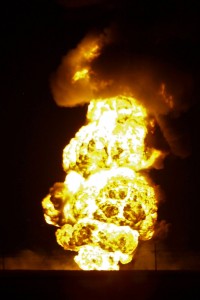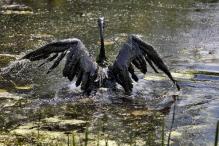Exploding Cornfield: Natural Gas Liquids Pipeline Turns into Fireball on Farm
 On Monday, August 12th, around 11:15pm, in Erie, Illinois, a cornfield exploded, shooting flames upwards of 300 feet into the air and leaving a crater 15 feet deep, 20 feet wide, and 40 feet long in the field. The explosion was visible for 20 miles. 80 families were evacuated from their homes. Luckily, no one was hurt.
On Monday, August 12th, around 11:15pm, in Erie, Illinois, a cornfield exploded, shooting flames upwards of 300 feet into the air and leaving a crater 15 feet deep, 20 feet wide, and 40 feet long in the field. The explosion was visible for 20 miles. 80 families were evacuated from their homes. Luckily, no one was hurt.
UPDATE: Comment here by September 14th 2013 midnight, to oppose bringing a natural gas liquids pipeline like the one that exploded one month ago today, to a terminal on the Delaware River! This pipeline, called Mariner East, is being built by Sunoco Logistics to carry liquids extractedy by fracking. The processing of fracked gas into liquids at the MarkWest facility in western PA is making people sick; more below.
The explosion was a result of a rupture in the natural gas liquids pipeline that runs underneath the cornfield. The pipeline is owned and operated by Enterprise Products, a Houston – based company. According to Enterprise, the cause of the rupture and explosion are not yet known.
See below for footage of the explosion as recorded by an eye witness:
This is not Enterprise’s first major offense. As recently as 2011, an Enterprise pipeline carrying 140,000 gallons of natural gasoline leaked an unknown amount of the volatile liquid into the Missouri River in Iowa. As reported by Selam Gebrekidan of Reuters, who covered the news about this leak in 2011, ‘There is no ‘real way’ of capturing fuel released into the Missouri River according to the EPA.”
The leak sprung in a 10 mile (16 km) stretch of Enterprise’s Conway North 33,600-barrels-per-day pipeline, which extends between Nebraska and Iowa.
The line was carrying up to 140,000 gallons of natural gasoline, a volatile liquid hydrocarbon derived from natural gas, when controllers detected a pressure drop on the line and shut down operations on Saturday.
Enterprise’s Conway North line is the latest in a string of pipeline accidents in a year, many of which — like the leaks from Enbridge Inc’s two crude lines last summer and the 1,000 barrels of crude oil spilled from Exxon Mobil’s Silvertip pipeline in July — have raised serious environmental concerns. – Selam Gebrekidan, Reuters
The Exxon leak that Gebrekidan mentions above is one of two spills that are featured in a recent New York Times article that details the aftermath of the Enbridge leak in the summer of 2010 and the Exxon spill of 2013, the country’s biggest pipeline disaster. Despite the industry’s clean-up attempts, the damages to the affected towns and surrounding ecosystems is permanent.
A Canada goose covered in oil attempts to fly out of the Kalamazoo River in Marshall, Mich., July 27. An estimated 877,000 gallons (3.3 million liters) of oil leaked from a pipeline into the river.
AP Photo/Kalamazoo Gazette, Jonathon GruenkeIt has been three years since an Enbridge Energy pipeline ruptured beneath this small western Michigan town, spewing more than 840,000 gallons of thick oil sands crude into the Kalamazoo River and Talmadge Creek, the largest oil pipeline failure in the country’s history. Last March, an Exxon Mobil pipeline burst in Mayflower, Ark., releasing thousands of gallons of oil and forcing the evacuation of 22 homes.
Both pipeline companies have spent tens of millions of dollars trying to recover the heavy crude, similar to the product Keystone XL would carry. River and floodplain ecosystems have had to be restored, and neighborhoods are still being refurbished. Legal battles are being waged, and residents’ lives have been forever changed.
“All oil spills are pretty ugly and not easy to clean up,” said Stephen K. Hamilton, a professor of aquatic ecology at Michigan State University who is advising the Environmental Protection Agency and the state on the cleanup in Marshall. “But this kind of an oil is even harder to clean up because of its tendency to stick to surfaces and its tendency to become submerged.” – Dan Frosch, New York Times
According to Frosch the industry is attempting to assure the public that these sorts of things will not happen on the regular:
Since the spills, the pipeline industry has emphasized that oil lines remain safe and reliable, and that major spills are rare. – Dan Frosch, New York Times
To that, I offer a list of pipeline accidents in the United States in the 21st century. The list is extensive and details the explosions and leaks beginning in 2000, all the way up to present time. The industry’s term rare does not seem to be accurate. For a more detailed list specifically about Enterprise’s recent offenses, you can visit the Stop The Seaway Pipeline movement, which is a movement to resist another one of Enterprise’s projects.
As pipelines all over the country are having accidents, the industry continues to put more in place.
In Pennsylvania, Sunoco Logistics is now building and permitting a natural gas liquids pipeline (like the one that just exploded in Illinois), to bring natural gas liquids to the Marcus Hook Refinery near Philadelphia. The pipeline is called the Mariner East, and it would begin at Mark West, (the natural gas plant that is currently making residents sick in Western PA), carrying the dangerous fuel east across the state through the Philadelphia region to Marcus Hook. The liquids will be used domestically, as a feedstock for plastics in processes causing further pollution; as well as sold internationally. We must resist this construction!
The recent incident of the Illinois cornfield demonstrates the reality that natural gas, natural gas liquids, crude oil, and tar sands oil (bitumen) can not be transported safely. Whether it be by pipeline, train, or truck, disasters abound and the consequences are virtually irreversible. We must fight the construction of these pipelines in our own state and support the residents of already affected areas.
Trackbacks
- Environmental Must-Reads – September 10, 2013 | Stuart H. Smith
- Oppose Mariner East Natural Gas Liquids Pipeline! | Protecting Our Waters
Comments are closed.


Trying to figure out the “apples and oranges” in “the country’s biggest pipeline disaster” (Exxon spill of 1,000 barrels of crude oil–Mayflower Ark) and “the largest oil pipeline failure in the
country’s history.” (Enbridge Energy rupture spewing more than 840,000 gallons thick oil sands crude into Western MI Kalamazoo River).
Come on folks, make me crazy, crude is crude, isn’t it? If so, let’s talk in the same units of measure Barrels or gallons–pick one. Pipelines also carry fluids like “natural” gasoline (a volatile liquid hydrocarbon derived from natural gas) usually measured in gallons.
Would there be any Standard Units of measure?
Actually, your questions seem easy to answer; not sure why you are asking. The Enbridge spill was the biggest at the time it occurred. The 2013 Mayflower Arkansas spill surpassed it. Gallons are the most common measure for a single spill while barrels per day is how liquids flowing in pipelines are often measured. Perhaps you are simply trying to distract from the enormity of the damage? People are naturally horrified by these deadly disasters, as well they should be.